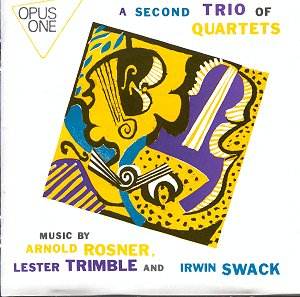 Composer: Irwin Swack
Composer: Irwin Swack
Works: String Quartet No. 4 (1986-90), String Quartet No. 1 (1950) by Lester Trimble, String Quartet No. 4 (1972) by Arnold Rosner
Performers: Alorian (Rosner), Ondine (Trimble), Sierra (Swack)
Recording: OPUS ONE 150CD [69.33]
Label: ONDINE
Irwin Swack’s String Quartet No. 4, alongside Arnold Rosner’s Fourth and Lester Trimble’s First, presents an engaging trilogy that underscores the diverse landscape of American string quartet composition from the late 20th century. This collection, curated by Max Schubel’s Opus One label, places Swack—an underappreciated figure—into a dialogue with more established contemporaries, lending an illuminating perspective on his stylistic evolution and compositional voice.
The recording opens with Rosner’s Fourth Quartet, which stands out for its intense drama and meticulous construction. Here, Rosner’s fastidiousness manifests in a structure that is both intricate and deeply expressive. The work’s opening movement, with its jagged motifs and sudden dynamic contrasts, recalls the tension found in Shostakovich’s later quartets. The incisive interplay between the instruments is executed with a fierce precision by the Alorian Quartet, who navigate the thorny passages with both clarity and emotional weight. The second movement’s slow unfolding offers a moment of respite, yet it is laced with a tragic undertow that is reminiscent of Vaughan Williams’s Tallis Fantasia. This emotional complexity and the thematic recapitulations throughout create a compelling narrative arc that resonates long after the final notes fade.
Lester Trimble’s String Quartet No. 1, performed by the Ondine Quartet, leans into a realm of dissonance that creates a stark contrast to Rosner’s work. With influences from Copland and Honegger, the quartet features a rich textural tapestry marked by angular lines and a pervasive sense of urgency. The musicians manage the intricate rhythms and harmonic shifts with impressive coordination, yet the piece’s thorniness may prove challenging for listeners seeking more conventional melodic resolutions. The Ondine Quartet renders this complexity with a fierce commitment, although moments of clarity occasionally succumb to a dense aural fabric, which may obscure Trimble’s more lyrical intentions.
Irwin Swack’s String Quartet No. 4, performed by the Sierra Quartet, is a revelation. His allegiance to the lyrical and romantic strains of Shostakovich and Bartók is palpable throughout the composition. The opening movement unfolds with a lyrical grace, juxtaposed against more astringent passages that evoke the tension found in Berg’s Violin Concerto. The Sierra Quartet articulates Swack’s contrasting ideas with a deftness that underscores his unique voice. The harmonic language is notably rich, yet the thematic development sometimes lacks the indelible impact that might elevate the work alongside those of his more prominent contemporaries. Nonetheless, Swack’s distinctive character shines, revealing a composer with considerable promise and a strong grasp of string textures.
The engineering quality of this recording is commendable, capturing the distinct timbres of each ensemble while maintaining a balanced soundstage. The clarity of the individual instruments allows for an appreciation of the intricate dialogues that unfold within each quartet. The recording remains faithful to the nuances of the performances, showcasing the technical prowess of the all-female quartets without sacrificing the emotional depth of the music.
This compilation of quartets offers a fascinating glimpse into the diverse and sometimes challenging soundscape of contemporary American music. The gritty emotional landscape painted by Rosner, the thorny textures of Trimble, and the promising lyricism of Swack together create a compelling narrative that is essential for enthusiasts of 20th-century chamber music. Each work contributes to a broader understanding of the evolving quartet tradition, firmly situating Swack within a context that, while not yet mainstream, certainly merits further exploration.



